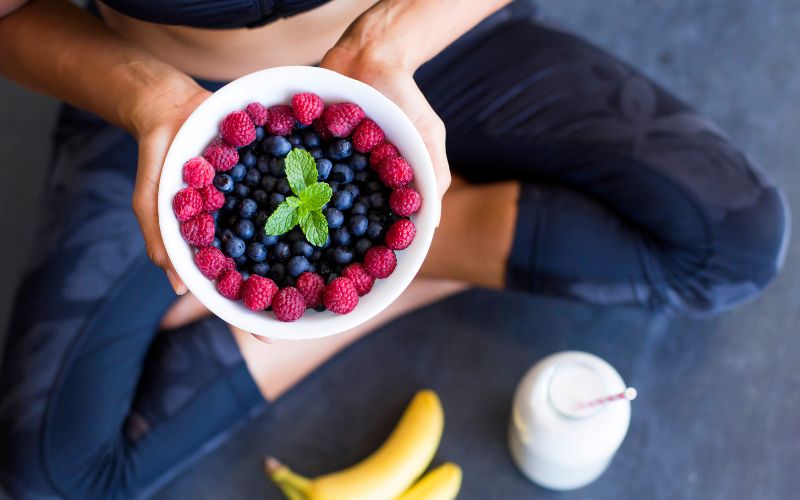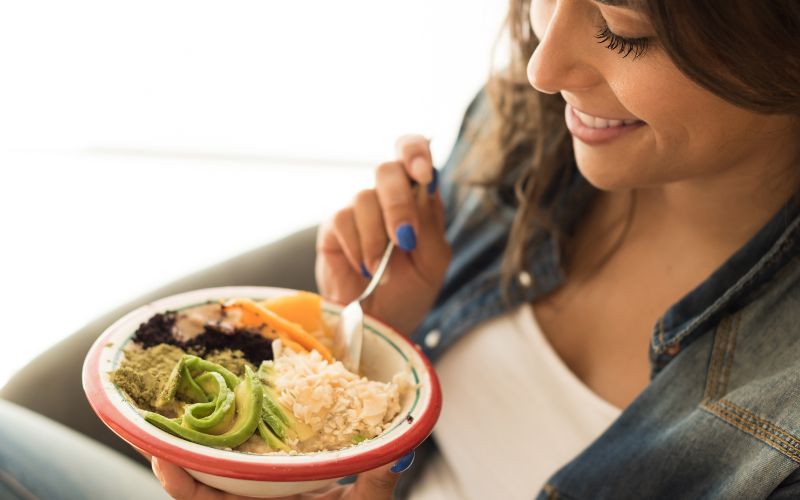Cycle Syncing Food - What You Need To Know
Cycle Syncing | By: Katie Lister
February 13, 2024
What is cycle syncing food? What types of food should I eat when cycle syncing? Can cycle syncing food help with PMS? This article will answer your questions if you are new to cycle syncing food.
Hi, my name is Katie Lister. I am the founder of Growth Gals and a Registered Nurse. I lead personal development groups and communities and coach women to step into the best versions of themselves.
GG provides women with a safe space to come together to learn and get support from other like-minded women. This article will provide the information you need to know about how to cycle sync food, and which foods to eat or avoid.
Table of Contents

Katie Lister
Written by Katie Lister, RN, BScN. An experienced Registered Nurse, Group Facilitator, Life Coach, and Community Leader. Read Katie's Full Author Bio
Why You Should Align What You Eat With Your Cycle?
A woman’s menstrual cycle is more than just her periods. It’s a continuous cycle of four different phases: menstruation, follicular phase, ovulation, and luteal phase. Throughout each phase, your hormonal fluctuation affects your energy levels, mood swings, sex drive, appetite, etc.
To flow with each menstrual phase, you can consider cycle syncing, which aligns your lifestyle to your menstrual cycle, from diet to exercise. Cycle syncing tracks your energy levels by detecting fluctuations in your sex hormones. Alisa Vitti, a nutritionist keen on women’s health, coined the cycle syncing practice. Vitti also authored a book on the subject, titled Woman Code, and created MyFLO. This period-tracking app tracks the phases of the menstrual cycle.
As mentioned, a cycle syncing diet is choosing which foods to eat or avoid in each menstrual cycle phase. Our nutritional needs change throughout our cycle, and eating the right foods at the right time can be challenging. Experts suggest creating meal plans and shopping lists per phase. These suggestions are not tailor-made for any individual, so you need to know what foods your body responds well to.
Foods and Balancing Your Hormones
Track your menstrual cycle via tracking apps to understand the phases of your menstrual cycle and physical ovulation signs. It can take up to 3 months to get it right, but it will eventually help. Choose whole foods, eat regularly to manage your blood sugar, and avoid spiking cortisol (stress hormone) throughout your cycle. Below are the foods to eat for hormonal balance:
- Cruciferous vegetables (Brussels sprouts, broccoli, cauliflower, cabbage, radish and kale)
- Healthy fats (avocados, avocado, olive and flaxseed oils, raw and unsalted nuts, and nut butter)
- Proteins
- Ground flaxseeds
- Low-sugar fruits (with skin)
- Herbs and spices with inflammatory qualities (ginger, paprika, sumac, turmeric, and garlic)
- Complex carbs (quinoa, buckwheat, and brown rice)
- Foods with Magnesium help with PMS (premenstrual syndrome) and PCOS (polycystic ovary syndrome) symptoms like severe cramping and bloating. Avocados, leafy green veggies like spinach and kale, nuts, tofu, whole grains and seeds.
- Ferments (olives, kefir or kimchi)
- Iron-rich foods replace blood lost in the shedding of the uterine lining during menstruation: lean meats like turkey or beef, leafy greens like kale and spinach, and legumes like chickpeas and lentils.
Avoid Eating:
Avoid these foods to prevent hormonal imbalances:
- Processed foods (bread, chips, sausages, bacon, etc.)
- Sugary foods and drinks
- Alcohol
- Caffeine
- Trans fats
- Too much red meat
- Soy products
- High-glycemic index carbohydrates (white bread, instant noodles, cornflakes, potatoes, fruit juice, etc.)
- Dairy products

Cycle Syncing Foods For the Follicular Phase
The follicular phase lasts from the time your period ends to the time of your next ovulation. During this time, your progesterone and estrogen levels are on the rise. The pituitary gland releases FSH, a follicle-stimulating hormone, and LH, a luteinizing hormone, to stimulate the growth of eggs in the follicles. Estrogen levels also increase in preparation for ovulation and potential pregnancy. Here are the best follicular phase foods options.
Eat:
- Omega-3 fatty acids: Nuts, fatty fish(salmon), avocado, seeds, eggs, plant-based oils and nut butter
- Magnesium: Seeds (chia, pumpkin), nuts (Cashews, almonds), black beans, spinach, soy products (edamame, soy milk), proteins (peanut butter), fish (salmon), dairy products (milk and yogurt)
- High fiber carbohydrates: Root vegetables (carrots, potatoes, carrots, etc.), whole grains (quinoa, oats, etc.), legumes (beans and lentils), fruits (kiwis, pears, etc.)
- Phytoestrogens (Phytonutrients that help to reduce estrogen’s effectiveness, relieving PMS symptoms, heavy periods, or fibroids.) These include flaxseed, sesame seeds, tofu, garlic, and dried fruits.
- Fermented foods : kimchi, kefir and sauerkraut
Avoid:
- Alcohol: Affects your hormone balance and liver function.
- Excess caffeine: Negatively affects your estrogen levels.
- Highly processed foods such as fried foods with high salt, additives, and unhealthy fats
- Excessive foods with phytoestrogens which affect your estrogen balance
Foods to Eat in the Luteal Phase
Progesterone prepares the body for a possible fertilized egg and implantation during the luteal phase. This phase occurs from the time of ovulation to the day before the first day of your next period.
Some of the best luteal phase foods to eat include:
Eat:
- Magnesium: Spinach, wholegrain, black beans, avocados, dark chocolate, cashews, almonds and dry roasted peanuts
- Calcium: beans, sunflower seeds, edamame, chia seeds, lentils and yogurt
- Proteins: Fish, lean meats, tofu, eggs, beans, leafy greens, chickpeas and lentils
- Vitamin B6: Tuna, salmon, chicken, sweet potato and chickpeas.
- Vitamin B12: Eggs, trout, and chicken breast. For vegans or vegetarians, eat nutritional yeast, fortified cereals, or take vitamin B12 supplements.
- Vitamin C: Citrus fruits, green bell peppers, sweet red peppers, strawberries, grapes, etc.
- Vitamin D: Cod liver oil, egg yolks, salmon, and fortified cereals
Can Cycle Syncing Food Help With PMS Symptoms?
When you tailor your diet and workout routine to align with your menstrual cycle, it’s easier to know what foods to eat and which to avoid. PMS (premenstrual syndrome) collectively refers to the signs and symptoms women experience a few weeks before their period.
Premenstrual syndrome (PMS) affects 48% of reproductive-aged women, with 20% experiencing severe symptoms that disrupt their lives. Hormones are chemical signals your endocrine glands release to harmonize your body functions. There are over 50 hormones produced by your body, making the term hormone imbalance a broad term.
If you notice a change in your health, menstrual cycle, or persistent PMS symptoms, consult a gynecology specialist for a diagnosis. A gynecologist may diagnose you with either PMS or PMDD (premenstrual dysphoric disorder), or any other underlying condition. Some treatment options they may recommend include:
- Hormonal birth control
- Mefenamic acid
- Supplements like Magnesium, calcium, or Vitamin B6
PMS symptoms include:
- Mood swings
- Food cravings
- Tender breasts
- Depression
- Fatigue and insomnia
- Feeling irritable, anxious, or upset
- Headaches
- Bloating
- Changes in sex drive and appetite
Cycle syncing food helps to:
- Improve your mood
- Reduce period symptoms like cramping
- Lower stress
- Reduce PMS symptoms
Can cycle syncing workouts help with PMS? Find out here.

Ideal Foods For the Menstrual Phase
When you have ruled out any underlying conditions, you can start tracking the different phases and eat accordingly.
Fatigue, irritability, and cramping are the most common PMS symptoms. Cravings make you eat comfort foods like sweets, chips, and pizzas. However, eating these foods during your periods will imbalance your sex hormones. You should instead eat:
- Iron-rich foods replace the lost iron during bleeding, like lentils, beans, leafy green vegetables, and lean red meat, which you can cook soups and stews.
- Vitamin C, which improves iron absorption, includes berries, citrus fruits, red bell peppers, and broccoli.
- Omega-3 fatty foods that reduce cramping and inflammation include tree nuts, flaxseed, salmon, and avocados.
- Vitamin K, which reduces heavy bleeding and includes foods like eggs, cheese, leafy greens, and blueberries.
- Antioxidants combat inflammation and oxidative stress caused by excess free radicals in your body, which cause cell damage and causes inflammation. Antioxidants neutralize the free radicals and repair the damage caused. Colorful fruits and vegetables are excellent antioxidants, so incorporating them into your diet can provide numerous health benefits.
Alleviate PMS symptoms by including different exercises in your cycle sync. During menstruation, you experience decreased energy, so exercising is excellent for your well-being. Workouts release serotonin, which is responsible for sleep, mood, and sexual desire. Exercise also releases dopamine, also known as the feel-good hormone. However, due to low energy, don’t do cardio, high-intensity interval training (HIIT), or strength training during this phase, but stick to low-intensity workouts like Pilates, stretching, and walking. Use this phase to rest and recover.
Cycle Syncing Food: How Growth Gals Can Help
At Growth Gals, we aim to inspire women to reach their full potential and exceed their expectations. We aim to create positive change by giving women the tools and resources to discover their true selves and expand their knowledge base. Growth Gals helps women overcome obstacles, make informed decisions on cycle syncing food, and connect with others with similar values and experiences. We also encourage women to live a healthy, authentic life that aligns with their values.
Be sure to register for our newsletter for the latest if you would like to learn more on managing your cycle and general personal development.
Conclusion
Cycle-syncing food is a way of countering hormonal changes during the menstrual cycle by eating the right foods for each phase. Know your cycle well by tracking your cycle via period-tracking apps. It may take about three months to settle down on a routine, but once you do, you can eat the right foods to alleviate PMS symptoms. If your symptoms every cycle are too adverse, see a gynecologist to rule out PMDD.
Joining a community like Growth Gals will help propel you toward your cycle-syncing food journey. Meet like-minded individuals who will offer a solid support system. They will also gladly help you navigate the world of cycle syncing food by sharing their experiences and knowledge on the subject.


